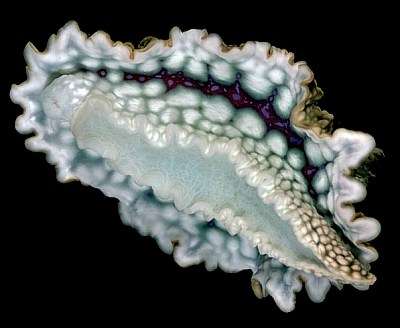
Ceratosoma miamiranum
(Bergh, 1875)
Order: NUDIBRANCHIA
Suborder: DORIDINA
Superfamily: EUDORIDOIDEA
Family: Chromodorididae
DISTRIBUTION
Indo-West Pacific
PHOTO
UPPER RIGHT: Underside showing characteristic colour pattern. Koumac Beach (=Baie de Ouanap), near Koumac, New Caledonia, 20°34'S, 164°16'E, Mixed soft and hard substrate, grassbeds, algae, 27 October 1993, 1 specimen (70mm long live). LOWER RIGHT: Dorsal view of same animal.
LOWER LEFT: Inner Makatumbe Is, Dar es Salaam, Tanzania, Dec 23 1973.
PHOTOS: Bill Rudman.
Note added 4 July 2007: The name is changed today from C. miamirana to C. miamiranum - see message #20101.
Formerly better known as Orodoris miamirana Bergh, 1875 and Fracassa tuberculosa Eliot, 1904, this species has recently been placed in the chromodorid genus Ceratosoma.
It has a relatively hard mantle with a series of rounded lobes around the edge. Smaller specimens have many compound tubercles and usually there is a median longitudinal ridge and a series of ridges running out from the longitudinal ridge to the mantle edge. As specimens grow in size these ridges can partially disappear. In smaller specimens the background colour can be a pale bluish-green with deeper green ridges, or the whole background can be a dark greenish-brown or reddish brown. Scattered all over are low rounded cream coloured pustules and some bright blue spots. Each of the blue spots is ringed with red. In larger specimens, the colour pattern can be much duller.
In all specimens I have seen from both East Africa and the western Pacific, the underside of the mantle has a very characteristic pattern. The background colour is bluish or greenish white and there is a reticulate pattern of green. Near the junction of the body and the mantle there is a ring of bright blue spots, each ringed with red.
-
Valdes, A. & Gosliner, T. (1999) Reassessment of the systematic status of Miamira Bergh, 1875 and Orodoris Bergh, 1875 Nudibranchia; Chromodorididae) in light of phylogenetic analysis. Journal of Molluscan Studies, 65: 33-45.
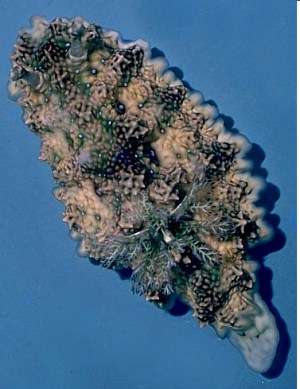
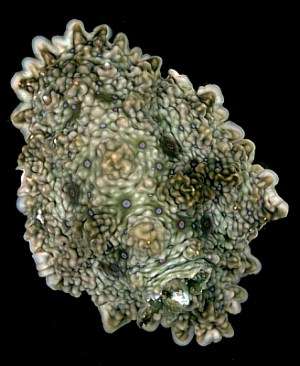
Rudman, W.B., 2000 (February 8) Ceratosoma miamiranum (Bergh, 1875). [In] Sea Slug Forum. Australian Museum, Sydney. Available from http://www.seaslugforum.net/find/ceramiam
Related messages
Re: Ceratosoma miamiranum from the Red Sea
November 12, 2009
From: Joe De Vroe
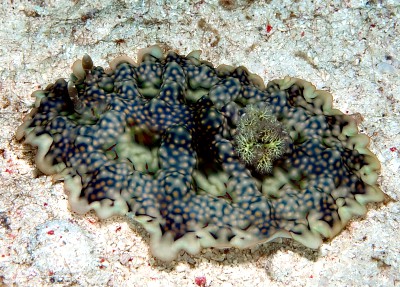
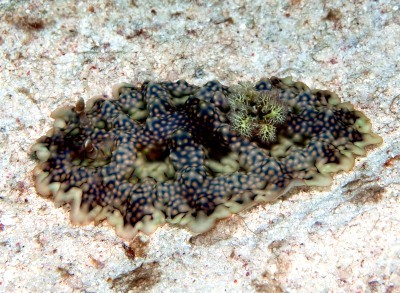
Concerning message #13229:
Dear Bill,
Is this Ceratosoma miamiranum ?
Locality: El Fanadir South (Hurghada - El Gouna), 18 m, Egypt, Red Sea, 17 October 2009, Sandy bottom. Length: 10 cm. Photographer: Joe DE VROE.
Kind regards,
Joe
joe.devroe@skynet.be
De Vroe, J., 2009 (Nov 12) Re: Ceratosoma miamiranum from the Red Sea. [Message in] Sea Slug Forum. Australian Museum, Sydney. Available from http://www.seaslugforum.net/find/22737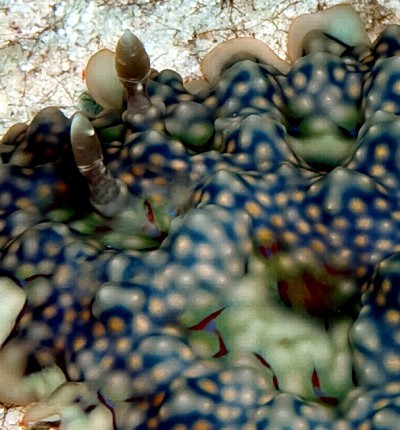
Dear Joe,
Yes this is C. miamiranum. The dorsal surface is quite variable in colour and yours is one of the most spectacular colour forms. One thing they all have in common [see Fact Sheet] is that the underside is white with a spectacular emerald green reticulate pattern.
Best wishes,
Bill Rudman
Ceratosoma miamiranum from the Philippines
July 22, 2008
From: Marcel Tanke
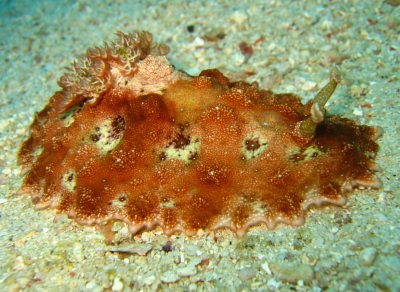
Concerning message #20614:
Dear Bill,
I checked the Platydoris in the pictures attached against all Platydoris species on your website, but could not find a fit. Do you know what species it is??
Locality: Anilao, site Kirby's Rock, 10 meters, Philippines, 12 July 2008, rocky / sandy bottom. Length: about 15-20 cm. Photographer: Marcel Tanke.
Further, it has a grey-whitish formation on its back, just in front of the gills. Any suggestion what that might be?
Best regards,
Marcel
marceltanke@cs.com
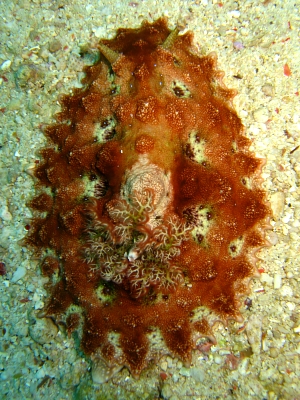
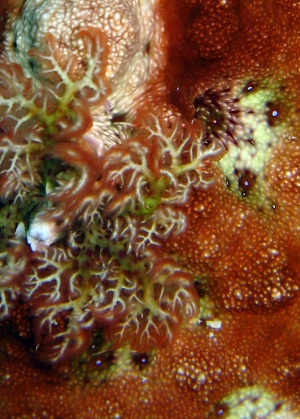
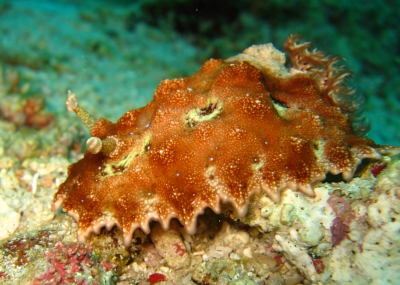
Dear Marcel,
Your animal certainly looks like a Platydoris, and its hard leathery consistency makes it feel like a Platydoris, but it is in fact a strange chromodorid, whose internal anatomy suggests it is a Ceratosoma. It certainly doesn't look much like most species of Ceratosoma, but the grey-whitish 'formation' in front of the gills which you ask about, may be a good clue. One characteristic of most species of Ceratosoma is the large recurved dorsal horn [see C. trilobatum]. Perhaps this 'formation' in your species is a very small 'dorsal horn'.
This is the brownish colored form of Ceratosoma miamiranum. It ranges from quite a bright orange -brown to a mottled green and it is often very well camouflaged. The best way to identfy this species is to turn it over - the bright white background with a network of green lines is present in all colour forms.
Best wishes,
Bill Rudman
Re: Ceratosoma miamiranum from Indonesia
June 10, 2008
From: Teresa Zuberbühler
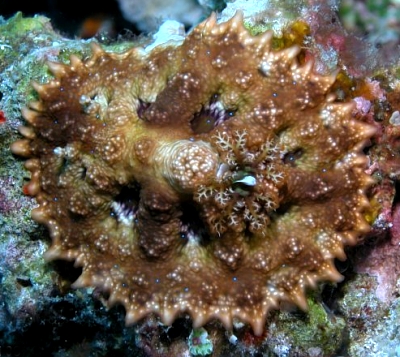
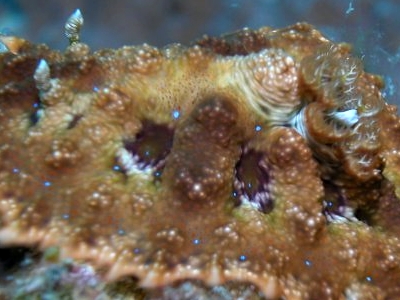
Concerning message #19040:
Dear Bill
Here another example of the brownish colored form of Ceratosoma miamiranum. It seems to me, that the bluish spots found in the three depressions in the mantle on both sides of the gills are also very typical (seen well on the photo of the nudibranch from above).
Locality: Togian Islands, 10m, Sulawesi, Indonesia, Pacific, July 2006, Reef edge. Length: 5-6 cm. Photographer: Teresa (Zubi) Zuberbühler.
Greetings
Zubi
webmaster@starfish.ch
Zuberbühler, T., 2008 (Jun 10) Re: Ceratosoma miamiranum from Indonesia. [Message in] Sea Slug Forum. Australian Museum, Sydney. Available from http://www.seaslugforum.net/find/21606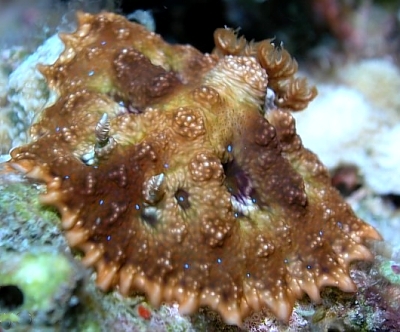
Dear Zubi,
Yes the pits with blue spots are characteristic, but sometimes quite difficult to see, as the dorsum is often very well camouflaged. That is why I think the 'gold' character for this species is the blue-green reticulate pattern on the underside.
--message--
Best wishes,
Bill Rudman
Ceratosoma miamiranum from North Sulawesi
September 4, 2007
From: Sebastian Ferse
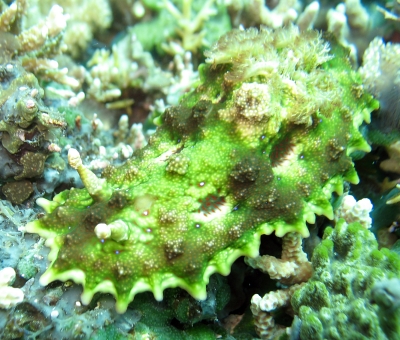
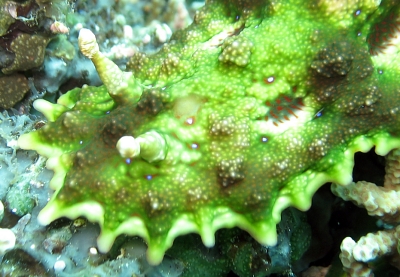
Hello Bill!
Here is another Ceratosoma miamiranum from North Sulawesi, Indonesia. In its shape it looks similar to the ones observed by Jim Anderson from West Papua and by Ahmad Zaki from Lembeh Strait (around the corner from where this one was observed), but its color is changed to perfectly match its surroundings, a brown Montipora coral and a green sponge. I wonder whether an individual is undergoing these color changes during its lifetime to match its surroundings? The reddish-brown individual from Lembeh Strait seems to point to this.
Locality: Muka Kampung, Gangga Island, 6 metres, North Sulawesi, Indonesia, Pacific Ocean, 23 June 2007, Shallow reef top with distinct coral/sponge community. Length: 10 cm. Photographer: Sebastian Ferse.
Sebastian Ferse
sebastian.ferse@zmt-bremen.de
Ferse, S.C.A., 2007 (Sep 4) Ceratosoma miamiranum from North Sulawesi. [Message in] Sea Slug Forum. Australian Museum, Sydney. Available from http://www.seaslugforum.net/find/20603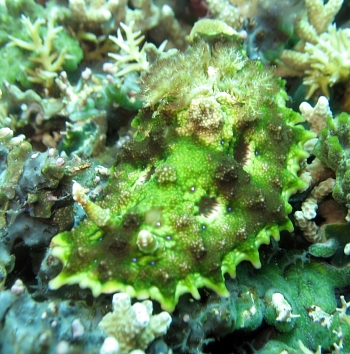
Dear Sebastian,
The wide colour variability in this species and the way it helps the animal blend into its background certainly suggests it has an ability to change colour, but I dont know of any studies on this. There are certainly other chromodorids which march the colour of their backgrouns - usually their food - very closely, such as Verconia verconis and some forms of Noumea haliclona, but in those cases the colour forms seemed to be genetically determined so you will find a yellow animal on a pink sponge and vice versa. even though when they are on their correctly coloured sponge they are almost invisible. There are also opisthobranchs that incorporate pigments and other elements from their food and so match the colour of their prey very well [see Colour Fact Sheet] but in the case of C. miamiranum I am not sure how it would do so because it would mean the sponge it feeds would also need to change colour to match the background colour as well. I guess that's not totally impossible, but it is starting to get a bit complicated. What we really need to find out is just what sponge C. miamiranum feeds on.
Best wishes,
Bill Rudman
Ceratosoma miamirana from the Philippines
June 20, 2007
From: Sean Kearney
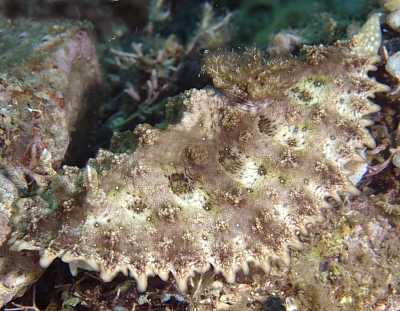
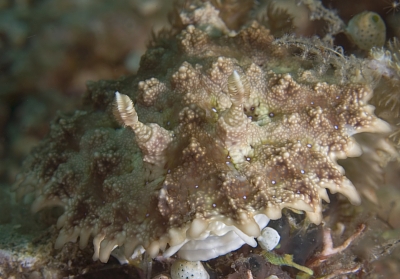
Dear Bill.
I was pleasantly surprised to find this fast moving beauty at the end of a dive in Puerto Galera, Oriental Mindoro, Philippines.
Locality: Puerto Galera, Oriental Mindoro, 10 meters, Philippines, South China Sea, 06 June 2007, sandy ledge. Length: 12-13 cm. Photographer: S. Kearney.
My first thought was that it looked just like a horned toad ... a type of desert dwelling lizard..I would like your help in id.
Thanks for your assistance.
I hope that this adds to the forum.
Sean
skearney@dc.rr.com
Kearney, S., 2007 (Jun 20) Ceratosoma miamirana from the Philippines. [Message in] Sea Slug Forum. Australian Museum, Sydney. Available from http://www.seaslugforum.net/find/20025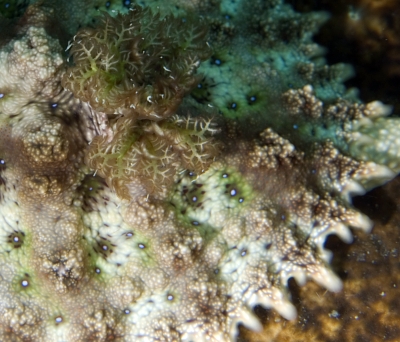
Dear Sean,
We are beginning to get quite a good set of photos showing variation in this animal, which is Ceratosoma miamirana. All we need now, or at least one thing it would be interesting to know, is what sponges it feeds on. It's funny how it reminded you of a desert lizard. I named another species Ceratosoma moloch, because it reminded me of Moloch horridus orThorny Devil, a spiny lizard found in the deserts of central Australia
Best wishes,
Bill Rudman
Another Ceratosoma miamirana from Indonesia
May 1, 2007
From: Jim Anderson
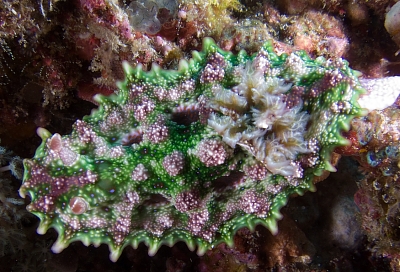
Hello again Bill,
Following a recent trip to Raja Ampat, Indonesia I am sending on some images that I trust will be of interest.
I think this one may be one of the colour forms of Ceratosoma sinuata.
Locality: Manta Point, Airborei, 15 m, Raja Ampat, Indonesia, Dampier Strait, 8 march 07, bombed out reef. Length: 100 mm. Photographer: Jim Anderson.
Jim Anderson
jander4454@gmail.com
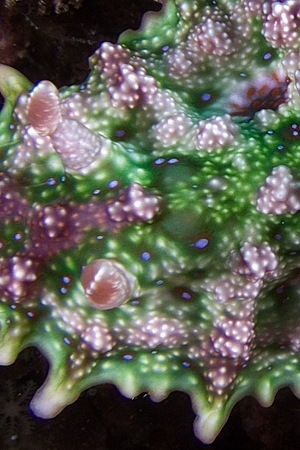
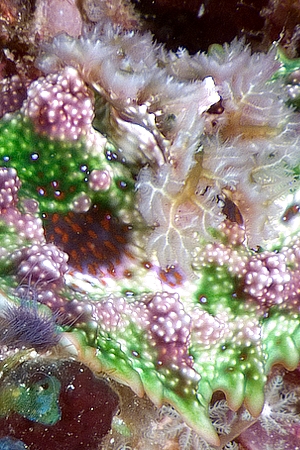
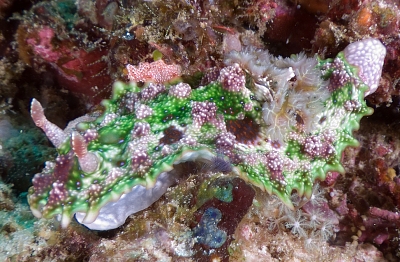
Dear Jim,
Although green, this is Ceratosoma miamirana rather than C. sinuata. The species is very variable in colour and often you have to see it very close up to be aware of the spectacular nature of its colour pattern. The bright blue 'eye spots' and the brownish tinge around the mantle edge are two fairly constant characters. The most distinctive feature, which is seldom seem, is the bright green network pattern on the underside of the mantle.
Best wishes,
Bill Rudman
Ceratosoma miamirana from Indonesia
May 1, 2007
From: Ahmad Zaki
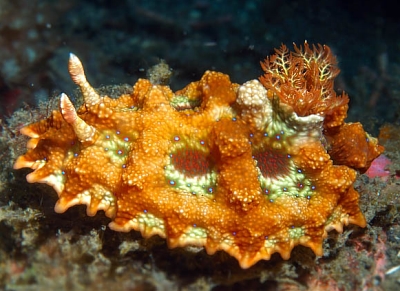
Dear Bill,
I took this picture a few days ago at the Lembeh Straits North Sulawesi. After some frantic searching I finally located this thread. And looking at all the variations and differences I am also wondering where it belongs... maybe should have been left as Orodoris miamirana..:-)
Locality: Lembeh Straits, 10 m, Indonesia, Celebes Sea, 12 Dec 2006, black sand. Length: 5 cm. Photographer: Ahmad Zaki.
Kind regards
Ahmad Zaki
ahmad.zaki@formis.net
Zaki, A., 2007 (May 1) Ceratosoma miamirana from Indonesia. [Message in] Sea Slug Forum. Australian Museum, Sydney. Available from http://www.seaslugforum.net/find/19040Dear Zaki,
This is another of the amazing colour forms of Ceratosoma miamirana. I would love someone to find it feeding on a sponge.
Best wishes,
Bill Rudman
Re: Unidentified Nudibranch from Guam
February 23, 2007
From: Bob Abela
Concerning message #19482:
Thanks for the ID help and follow up discussion everyone.
So, are juvenile C. miamirana typically white and, as they mature, change colors? Or are we dealing with color variation, independent of developmental stage?
Bob Abela
babela@guamcell.net
Abela, R. A., 2007 (Feb 23) Re: Unidentified Nudibranch from Guam. [Message in] Sea Slug Forum. Australian Museum, Sydney. Available from http://www.seaslugforum.net/find/19517Dear Bob,
I must say that I had never seen a white animal like yours before, but I recognised it from its general shape, green patches and fine gills. We know very little about this species so it is not possible to link 'whiteness' with immaturity, although both the white specimens we have on the Forum were small animals. However perhaps the link is Guam rather than size? I mentioned that at times this species is remarkably well camouflaged against its background environment so there is always the possibility that in Guam they are living on whitish coralline rock.
What we need is a lot more information.
Best wishes,
Bill Rudman
Re: Unidentified Nudibranch from Guam
February 19, 2007
From: Hugues Flodrops
Concerning message #19470:
Dear Bill,
It isn't possible to be a pale form of Dendrodoris denisoni with blue spots too.
Thanks for your comments and the forum.
Bests regards.
Hugues.
hugues.flodrops@wanadoo.fr
Flodrops, H., 2007 (Feb 19) Re: Unidentified Nudibranch from Guam. [Message in] Sea Slug Forum. Australian Museum, Sydney. Available from http://www.seaslugforum.net/find/19474Dear Hugues,
Blue spots like those of C. miamirana are not exclusive to that species. found also in a number of species of sea hares, and as you have noted, Dendrodoris denisoni. Although you can't tell from photos, Ceratosoma miamirana has a stiff and solid mantle skirt, quite unlike the thin frilly mantle edge of Dendrodoris denisoni. One feature you can note from the photos is how the edge of the mantle seems to be cut out in a wavy or scalloped shape. If you look at other photos of this species, that is very characteristic of C. miamirana as well. However if you find a live animal, the best check is to turn it over and see the green reticulate pattern.
Best wishes,
Bill Rudman
Re: Unidentified Nudibranch from Guam
February 19, 2007
From: Clay Carlson
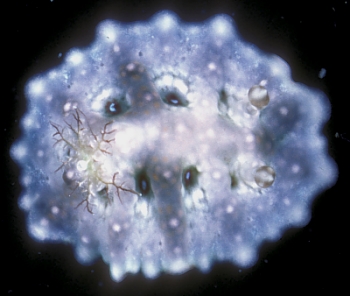
Concerning message #19470:
Bill,
Here is an aged photo [Not the best, but use it if you wish!] of a somewhat intermediate (age-wise) color form of Ceratosoma miamirana. The white form we have in our collection was 12 mm.
Locality: Sella Bay, 5m, Guam, Western Pacific, 29 February 1971. Length: 29 mm. Photographer: Clay & Patty Jo.
Clay & Patty Jo
ccarlson@guam.net
Carlson & Hoff, 2007 (Feb 19) Re: Unidentified Nudibranch from Guam. [Message in] Sea Slug Forum. Australian Museum, Sydney. Available from http://www.seaslugforum.net/find/19482Dear Clay,
Thanks for the photo. It's nice to fill in another gap from juvenile to adult
Best wishes,
Bill Rudman
Ceratosoma miamirana from Heron Island
February 19, 2007
From: Julie Marshall
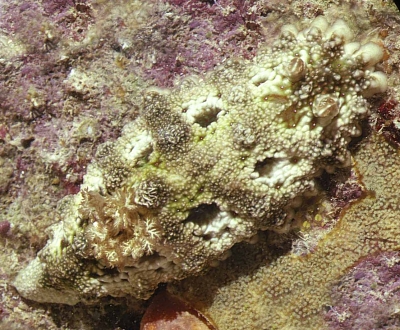
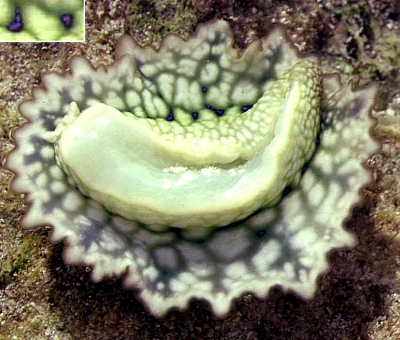
Dear Bill,
Following the photos of the very brightly coloured Ceratosoma miamirana from Indonesia [message # 19458 ] attached are photos of a more usual colour form of this species from Heron Island [Great Barrier Reef]. The photo of the ventral side of the animal clearly shows the blue iridescent spots. It was found crawling over coral sand in a pool near the reef crest at low tide.
Locality: Heron Island, 1 m., Queensland, Australia, Pacific Ocean, January 1993, Intertidal. Length: 80 mm. Photographer: Julie Marshall.
Best wishes,
Julie Marshall
juliemarshall@netspace.net.au
Marshall, J.G., 2007 (Feb 19) Ceratosoma miamirana from Heron Island. [Message in] Sea Slug Forum. Australian Museum, Sydney. Available from http://www.seaslugforum.net/find/19485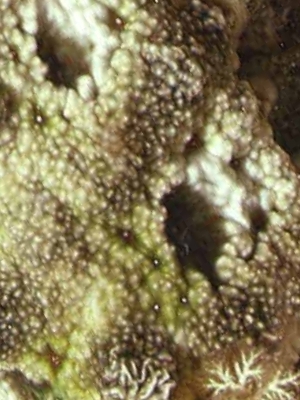
Thanks Julie,
This species can be very well camouflaged. Yours looks very like an overgrown sponge colony, the dark pits along each side looking like the oscules [siphons] of a sponge. Both the very scalloped mantle edge, and these greenish pits, are two characteristic features of the mantle which link your 'normal' animal to the reddish one you have mentioned, and also to the whitish specimen from Guam [message #19470]. Of course if we could just turn the photos over I am sure they would both have the green network on the underside, which is shown so well in your photo.
Best wishes,
Bill Rudman
Unidentified Nudibranch from Guam
February 16, 2007
From: Bob Abela
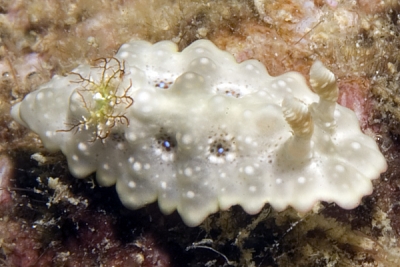
Dear Bill,
First time writing but I've been a fan of your forum and refer to it all the time.
I have a couple pictures to share of a small nudibranch that has me baffled. Perhaps you can help offer a name?
Locality: Agat Bay, Approximately 25 ft, Guam, Western Pacific, 23 January 2007, Aggregate reef, not far beyond the reef edge, predominantly covered by macro algae.. Length: Approximately 1 cm. Photographer: Bob Abela.
Sincerely,
Bob Abela
babela@guamcell.net
Abela, R. A., 2007 (Feb 16) Unidentified Nudibranch from Guam. [Message in] Sea Slug Forum. Australian Museum, Sydney. Available from http://www.seaslugforum.net/find/19470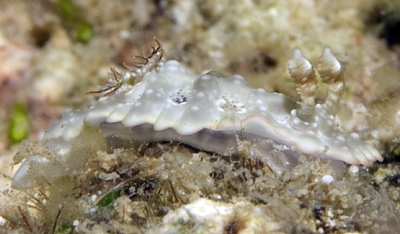
Dear Bob,
I have never seen such a pale version of this species, but I am pretty sure it is Ceratosoma miamirana. By chance I am posting a message from Mike Krampf today [message #19458] of a strange reddish ornage form of the same species. You will note his animal has the same blue spots down each side and the fine green and brown edging to the gills. This species is also characterised by a reticulate green pattern on the underside of the mantle, but I am not sure if an animal this small would have any traces of it.
Best wishes,
Bill Rudman
Ceratosoma miamirana from Raja Ampat, Indonesia
February 16, 2007
From: Mike Krampf
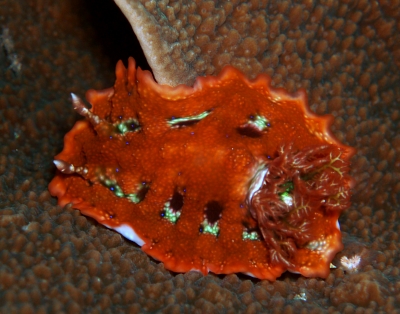
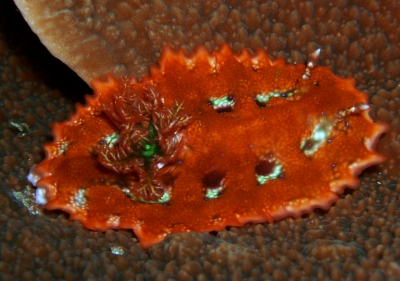
Dear Bill
This was one of the most unique nudi's that I've seen and after searching many references I still have no any idea what species it is. Our divemaster who has been diving in Raja Ampat for over 3 years had never seen this one before either. Your help as always is greatly appreciated.
Locality: Dive Site - Teluk Baru off Salawati Island, 50 ft, Raja Ampat, Indonesia, Banda Sea, 26 December 2006, Reef. Length: 3-4 cm. Photographer: Mike Krampf.
Cheers,
Mike
mtkrampf@yahoo.com
Krampf, Mike, 2007 (Feb 16) Ceratosoma miamirana from Raja Ampat, Indonesia. [Message in] Sea Slug Forum. Australian Museum, Sydney. Available from http://www.seaslugforum.net/find/19458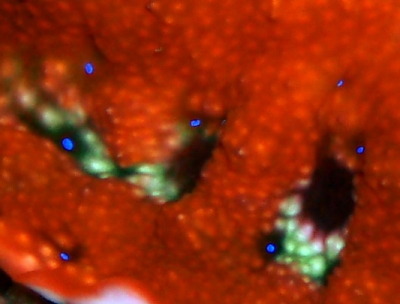
Dear Mike,
When I first saw your photos at about one tenth of their full size I had no idea what you had found, but when I saw them full size, the bright blue spots rang a very large bell in my brain. The animal is Ceratosoma miamirana. It is usually a greenish or green-brown colour dorsally - I have never seen this bright orange red colour before. I don't suppose you had a look at the underside of this animal? If you had it would have been white with a characteristic green reticulate pattern and a row of blue spots - as on the Fact Sheet.
I am not sure what it is doing on this coral. Like all chromodorids, it is a sponge feeder.
Best wishes,
Bill Rudman
Ceratosoma miamirana from Numoku Iki Tonga
April 6, 2006
From: Jennifer Eaton
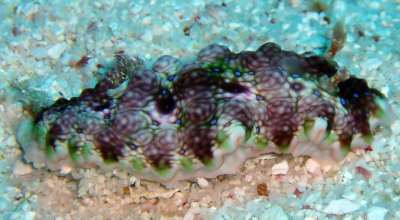
Hello
I am trying to find out what sort of nudibranch I have stumbled upon. We were diving in a spot off the south side of Numoku Iki, Ha 'apai, Tonga when this little guy showed up.
I have as yet been unable to identify him, but, I am a new nudibranch fan.
Locality: reef off Numoku Iki, 60 -70 feet, Ha 'apai, Tonga, Pacific, August 2005, sandy patch inside reef. Length: 1.5 inches. Photographer: Jennifer Eaton.
Thanks for your time
Jennifer
jeneaton1@yahoo.com
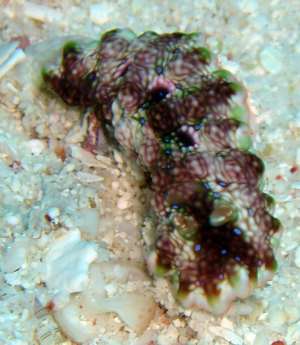
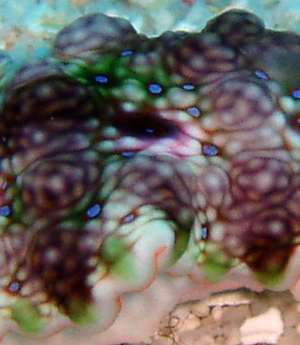
Dear Jennifer,
This is Ceratosoma miamirana. You really need to see it close-up to apreciate its colour pattern, although some specimens are not as well coloured as yours. In fact the most characteristic feature of this species is the beautiful green-blue reticulate pattern on the underside of the mantle and sides of the body - which of course you can't see in most photos which are taken from above.
Best wishes,
Bill Rudman
Ceratosoma miamirana from the Red Sea
March 3, 2005
From: Matan Ninio
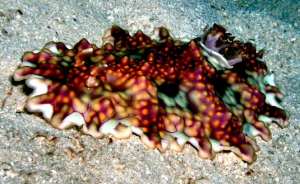
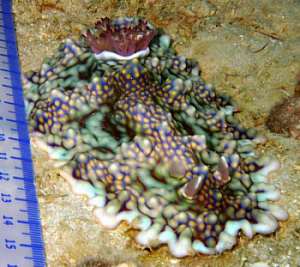
Dear Bill,
Here are some photos of Ceratosoma miamirana.
The top animal, 14 cm long alive, was photographed in the Dekel Beack, Eilat, Israel (Red Sea), at about 20m depth, on the 21 Feb 2005 (By Sheikh Sliman of the Tapuz Z'lila tribe).
A simular animal [lower photo ] was photographed by Shai Beisky in Jan, 2004, at the same location.
Matan Ninio
matan@forumhasofiot.yam.dive.ninio.org
Ninio, M, 2005 (Mar 3) Ceratosoma miamirana from the Red Sea. [Message in] Sea Slug Forum. Australian Museum, Sydney. Available from http://www.seaslugforum.net/find/13229Dear Matan,
Thanks for these records. I am surprised that both animals are so large. The largest I have seen are about 7 cm long.
Best wishes,
Bill Rudman
Ceratosoma miamirana from Malaysian Borneo
November 12, 2003
From: Grace Lim
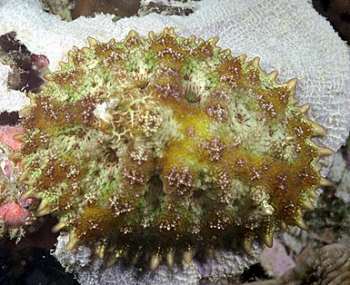
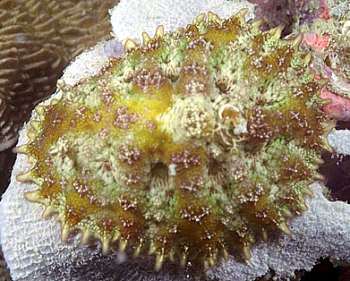
Dear Dr. Rudman,
Here are pictures of a nudibranch taken at Lankayan Island, east coast of Malaysian Borneo. It was spotted by Reuben, the dive master at the resort. It was their first time seeing this creature and pictures were
taken by Rick Greatting at South Point between 15 - 20 metres in September 2003. We are all very excited about it. Appreciate if you could identify this species.
Many Thanks & Regards
Grace Lim
grace@geckotrails.com
Lim, G., 2003 (Nov 12) Ceratosoma miamirana from Malaysian Borneo. [Message in] Sea Slug Forum. Australian Museum, Sydney. Available from http://www.seaslugforum.net/find/11407Dear Grace,
This is Ceratosoma miamirana. It looks more like a normal dorid than a member of the genus Ceratosoma and is rarely seen. However I suspect its supposed rarity is a result of its camouflage colour pattern making it almost invisible to the casual observer. However its most distinctive feature is its under-side. I have a photo on the species Fact Sheet showing the network of green and the blue spots which mark the side of the foor and underside of the mantle.
Best wishes
Bill Rudman
Re: Ceratosoma miamirana and possible food
June 16, 2000
From: Mary Jane Adams
Dear Bill,
Thanks for your comments. I suspected the sponge I found the C. miamirana on might be a prey item since it was an identical shade of cinnamon brown. I looked very closely, but could not see any missing sponge under or around the slug. Is it possible it was eating the slime off the sponge? I went back to the sponge a couple of hours later, but the slug was gone.
Thanks for all you have taught me about sea slugs.
Best regards,
Mary Jane
mjadams@earthlink.net
Dear Mary Jane,
I'm afraid sometimes its difficult to get from the 'hunch' stage to some real evidence.
I'm sure that mucus would not sustain an animal although at times people have suggested it as a possible food. While in some cases it is easy to see where a sponge has been partially eaten, these leathery sponges need to be quite seriously bitten before the damage is noticeable. I mentioned the possibility that the sponge was a food item because I am always optimistic, but my main aim was to alert you and other readers to the potential we all have to make an interesting discovery.
I'm glad you are enjoying the Forum,
best wishes,
Bill Rudman.
Ceratosoma miamirana from Papua New Guinea
June 14, 2000
From: Mary Jane Adams
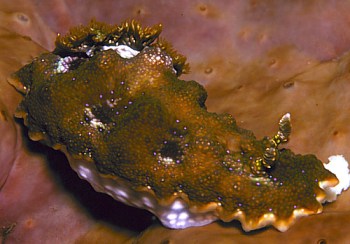
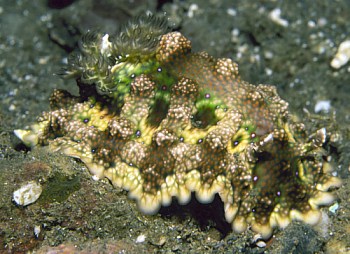
Dear Bill,
I believe these are both Ceratosoma miamirana.
UPPER PHOTO: This brown one was sitting on a brown sponge on top of a coral bommie near Sanaroa Island, Milne Bay Province, Papua new Guinea. Depth: 9 meters, length: 75 mm. May 22, 2000
LOWER PHOTO: This lighter colored one is from Luadi, Milne Bay, Papua New Guinea. It was about the the same size, 4 meters deep, on a sandy bottom with patch reef. March 1, 1999.
These are the only two I have seen. I think they are very beautiful animals.
Regards,
Mary Jane
mjadams@earthlink.net
Adams. M.J., 2000 (Jun 14) Ceratosoma miamirana from Papua New Guinea. [Message in] Sea Slug Forum. Australian Museum, Sydney. Available from http://www.seaslugforum.net/find/2526Dear Mary Jane,
I agree that these are beautiful, especially the colours on the underside of the mantle and the foot (See top of page).
I am very interested to see the brown animal on the brown sponge which looks very much like a dendroceratid sponge of the family Halisarcidae which form a tough leathery, almost slimy layer over rocks or other hard surfaces, looking more like a compound ascidian than a sponge. This is the type of sponge that Actinocyclus and some species of Hallaxa feed on. It would be interesting to know if C. miamirana is just passing across this sponge or feeding on it.
Best wishes,
Bill Rudman.
Ceratosoma miamirana from Okinawa
February 13, 2000
From: Kazuko Matsuda
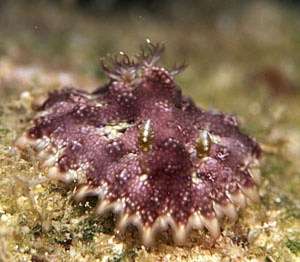
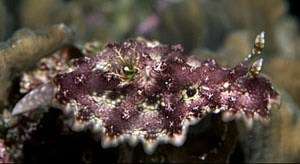
Dear Bill
This is the Ceratosoma miamirana I found at the same point I saw the juveniles of the 'Miamira-group'.
Data:
21 November 1999, depth: 20m, length: 30mm
I am also very interested in seeing how those juveniles grow.
Kazuko
Kazuko Matsuda
matsu@ii-okinawa.ne.jp
Matsuda, K, 2000 (Feb 13) Ceratosoma miamirana from Okinawa. [Message in] Sea Slug Forum. Australian Museum, Sydney. Available from http://www.seaslugforum.net/find/1876Dear Kazuko,
Thanks for the photos. It mad me realise I didn't have a page on this species so I have added one. It is one of the few chromodorids which appears to be camouflaged, although the bright green pattern, and blue spots on the white underside are very recognisable.
Best wishes,
Bill Rudman.
